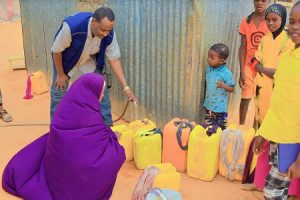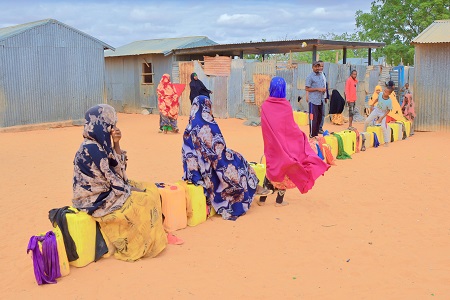“Our lives have changed; thanks to water that we now have in our camp”
For just over a month, from 7 May to 16 June 2022, Fatumo Yusuf Diriye spent 3 hours every day, walking to and from the nearest water source, 6 km away, to fetch water for her family. As she could carry only 2 ‘jirigaans” or pails of water at a time, and had to wait her turn in a long queue, her family had to use this water sparingly. They resorted to using ashes or sand to clean their hands.
Fatumo knows that having to deal with unsafe water has contributed to her 3 children under 5 falling sick with diarrhoea many times before. On many occasions, she has had to rush them to the nearest health facility for support. This is one burden that families like Fatumo’s, who depend on her daily earnings from a local market, can do without.
Visit from the Government and WHO officials
One day, early in May 2022, Fatumo heard there was a team of high-level officials from the Government and World Health Organization (WHO) visiting the camp where she lived, in North Galkayo, to assess the effects of the ongoing drought. Even though she could not go to see them, later on, she heard a few community members had requested the heads of the high-level team to support them to fix 2 water pumps which were not functioning for longer than she could recall. The Salama water pump, which is a borehole close to Fatumo’s home, was one of them, and the Halaboqad borehole was the second one that hadn’t been functioning for quite some time.
The visiting high-level team was led by HE Dr Fawziya Abikar Nur, the Federal Minister of Health and Human Services, and HE Abdi Nasir Yusuf Haji, the Vice Minister of Health for Puntland state. Representing WHO, Dr Ahmed Al-Mandhari, WHO Regional Director for the WHO Eastern Mediterranean, and Dr Mamunur Rahman Malik, WHO Representative to Somalia, were also part of the team.
Fatumo, who has been living in a camp for the internally displaced since 2017, had heard the WHO team agreed to provide support, but was not sure how this would pan out. To her joy and surprise, within a few days, an expert came by to assess the Salama borehole. Around a month later, the Salama borehole was functioning again.
“Our lives have changed thanks to having water now from the Salama borehole, for drinking and also for all our household purposes,” says Fatumo, as it takes her just 30 minutes to fetch water now. The Diriye family can now collect at least 4 buckets of water, as their source, the borehole, is just above half a kilometre away. Hers is just one of the families living in one of 6 camps and 2000 households that now have access to clean water from the Salama borehole.
With WHO’s interventions to rehabilitate both the Salama and Halaboqad boreholes, 19 716 people now have access to clean water. This will translate to clean drinking- water, fewer waterborne diseases, like cholera and diarrhoea, healthier populations, and better sanitation. By protecting their families from preventable diseases, Fatumo and many parents like her can devote their time and resources to raising their families instead of coping with the stresses related to fighting diseases.

Access to water is a recognized human right
Photo-3-water-sources
Fatumo carries water back home to top up her supply for the day. Credit – WHO/Somalia
Currently, only 52% of the population in Somalia has access to improved drinking-water (the population using safely managed drinking-water services). In the internally displaced persons’ (IDP) camps like Salama, this number is staggeringly low. Recurring droughts, such as the one ongoing, make water an even more scarce resource.
Around the world, WHO and the United Nations Children’s Fund (UNICEF) found that in 2019, 2.2 billion people lacked access to safely managed drinking-water services. In July 2010, the United Nations General Assembly recognized access to water and sanitation as a human right. The Health Assembly acknowledged that every human needs to access “between 50 and 100 litres of safe, acceptable and affordable water a day for personal and domestic uses”. The General Assembly also stated that families’ main water source should be within 1 km of their home and that it should not take longer than 30 minutes for a family to access water.
To complement this, the UN Sustainable Development Goal (SDG) 6 aims to ensure availability and sustainable management of water and sanitation for all. This will reduce the burden of waterborne diseases, and advance progress towards universal health coverage.

